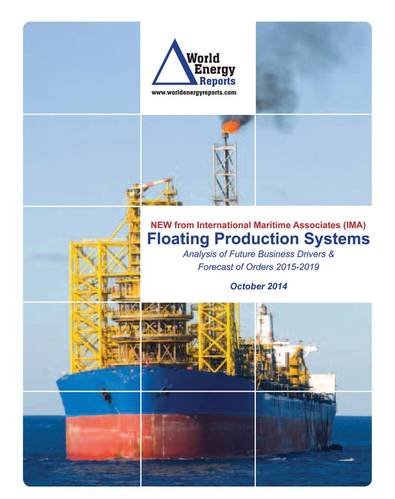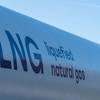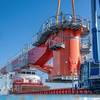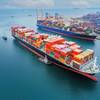What’s New in Floating Production?
What’s New in October 2014?
Today 324 oil/gas floating production units are now in service, on order or available for reuse on another field. FPSOs account for 65% of the existing systems, 78% of systems on order. Production semis, barges, spars and TLPs comprise the balance. The oil/gas production floater inventory is the same as last month. There were no orders for additional production systems in September. Another 30 floating LNG processing systems are in service or on order. Liquefaction floaters account for 17%, regasification floaters 83%.
No liquefaction floaters are yet in service – all 5 are on order. Total LNG inventory has increased by one unit since last month, the result of an order for an FSRU to be positioned in Dubai. DUSUP in September awarded Excelerate a ten year charter to provide/operate an FSRU in Jebal Ali. This will be a second FSRU in the port -- the Golar Freeze is already operating as a regas terminal in Jebal Ali. An existing Explorer-class regas carrier will be modified to be able to produce 800 mmcf/d. Operation is to start in 2016. In addition, 102 floating storage units are in service, on order or available.
Floater Projects in the Planning Stage
233 floating production projects are in various stages of planning as of beginning September. Of these, 58% involve an FPSO, 13% another type oil/gas production floater, 23% liquefaction or regasification floater and 6% storage/offloading floater. Two units were delivered during the month.
Brazil, Africa and SE Asia continue to be the major locations of floating production projects in the visible planning stage. We are tracking 43 projects in Brazil, 49 in Africa and 40 projects in SEA – 57% of the visible planned floating production projects worldwide. Several large projects in Brazil and (less so) Africa will require multiple production units. Overall, up to 275 production floaters of various types will be required for the 233 projects we are tracking.
Around 15% of the 233 visible planned projects are likely to advance to the EPC contracting stage within the next 18 months. These projects typically have either entered the FEED phase, pre-qualification of floater contractors has been initiated or bidding/negotiation is in progress. Another 48% of the visible projects are at a stage of development where the EPC contract for the production unit is likely within the next 18 to 48 months. The remaining 37% of projects are less advanced in planning, with the EPC contract likely 4 to 10 years out.
New Forecast of Production Floater Orders
We have just completed a detailed analysis of the outlook for production and storage floater orders over the next five years.
Utilizing our database of planned projects, we use a bottom up approach to establish the likely number of floating production projects to reach the investment stage between 2015 and 2019.
Then we analyze the underlying business drivers likely to exist during this period – and assess how these drivers will likely impact the pace of investment decisions in project development starts.
Having a large number of projects at the investment stage is certainly important. But ultimately, the field operator has to feel comfortable making the investment.
The investment environment will determine whether projects go forward, get delayed or be considered non-starters.
In our report we examine twelve underlying business drivers that will influence the pace of investment in floating production project starts. Some of these are positive drivers. Some are negative. All have an impact on the number and timing of future production floater orders.
In the positive category are:
• oil and gas demand keeps growing as world output and population grows
• supply disruption keeps the focus on finding new sources of supply
• oil prices are holding around $100 – though prices have been weakening lately
• many more deepwater drillships/rigs are entering service
• the financial market is more open than several years back – capital cost is low
In the negative category are
• major energy companies are cutting back on capital expenditures
• a lot more supply has suddenly come into the oil and gas market
• shale/tight oil and gas projects are competing for investment funds
• constraints in the supply chain are creating delays and overruns
• cost escalation is impacting the viability of deepwater projects
In the unknown category are
• how competitive will deepwater be with shale oil supply
• will a black swan event impact the sector
The result is a forecast of orders that reflects the growing number of projects in the planning pipeline and a future pace of ordering that reflects the uncertainty about underlying business conditions in which investment decisions are made. Details about our new October 2014 forecast report and the new online floating production database are available at:
www.worldenergyreports.com
IMA provides market analysis and strategic planning advice in the marine and offshore sectors. Over 40 years we have performed more than 350 business consulting assignments for 170+ clients in 40+ countries.
t: 1 202 333 8501
e: [email protected]
(As published in the October 2014 edition of Maritime Reporter & Engineering News - http://magazines.marinelink.com/Magazines/MaritimeReporter)
















